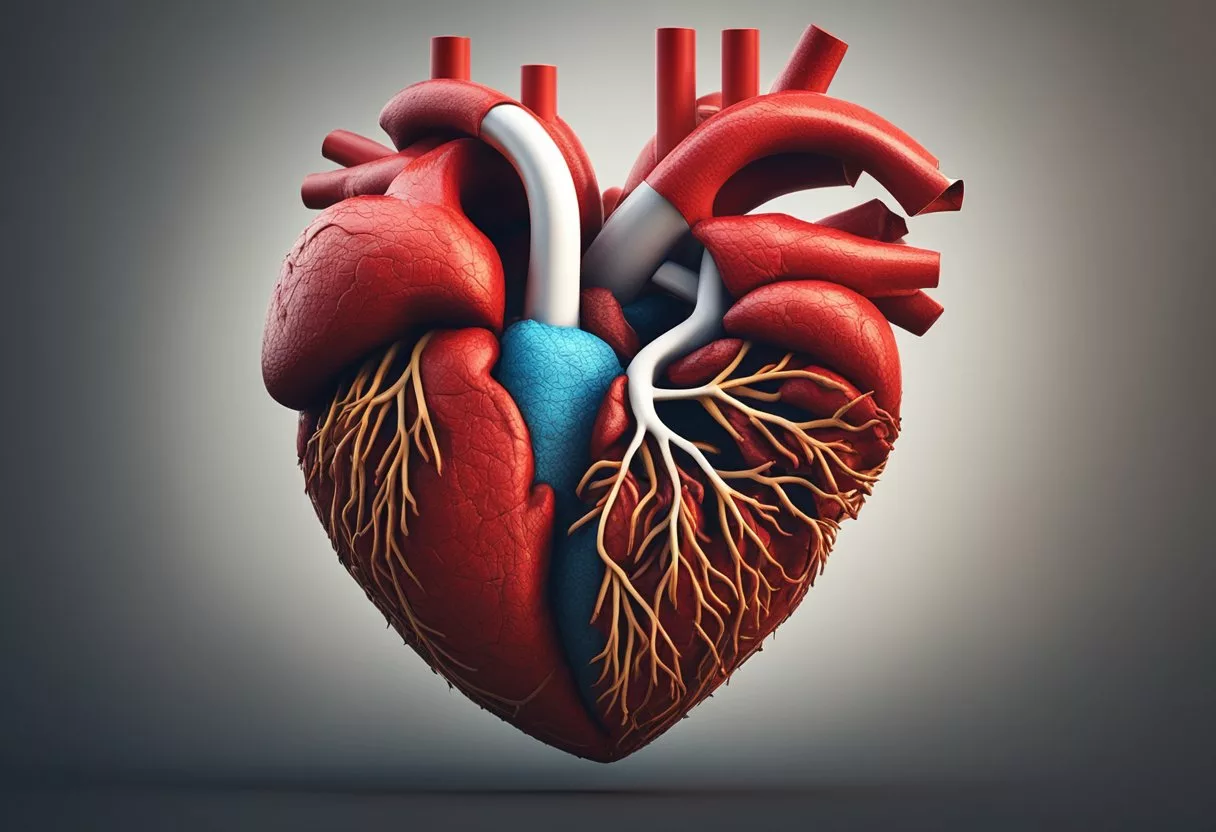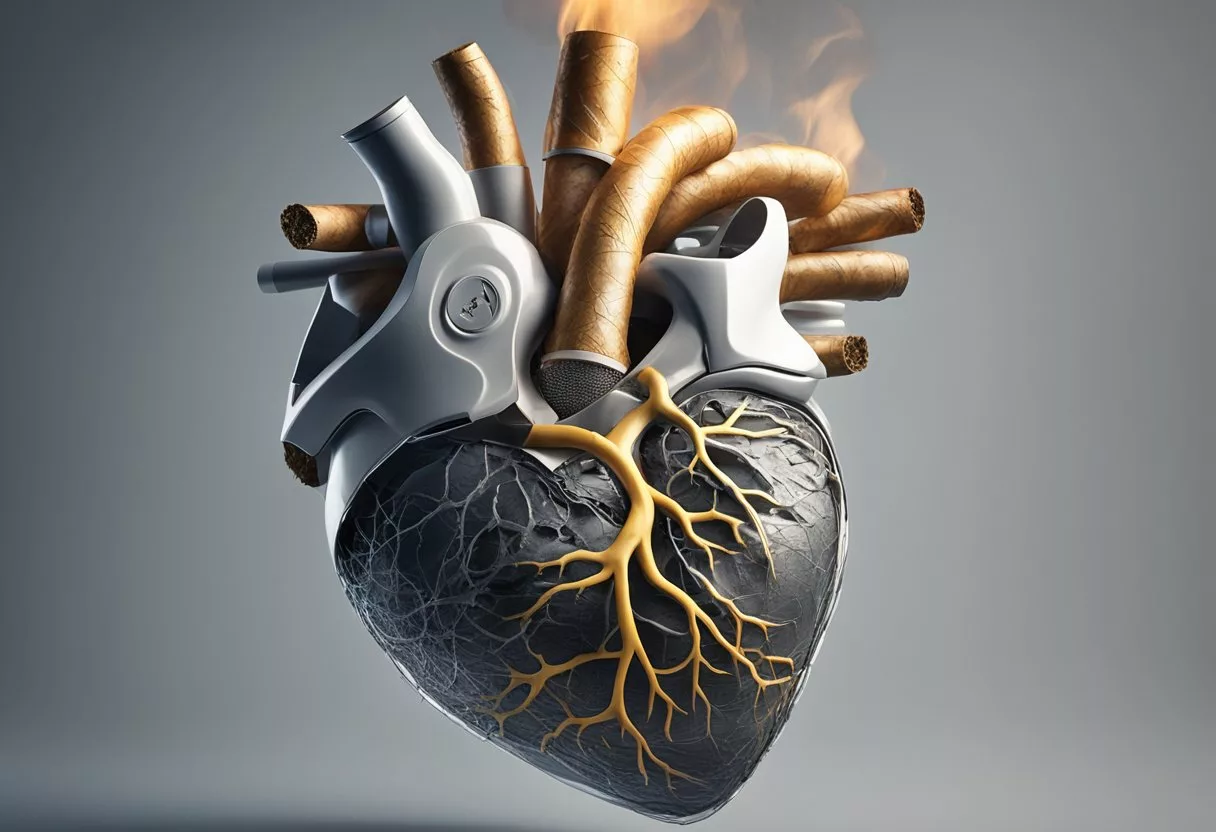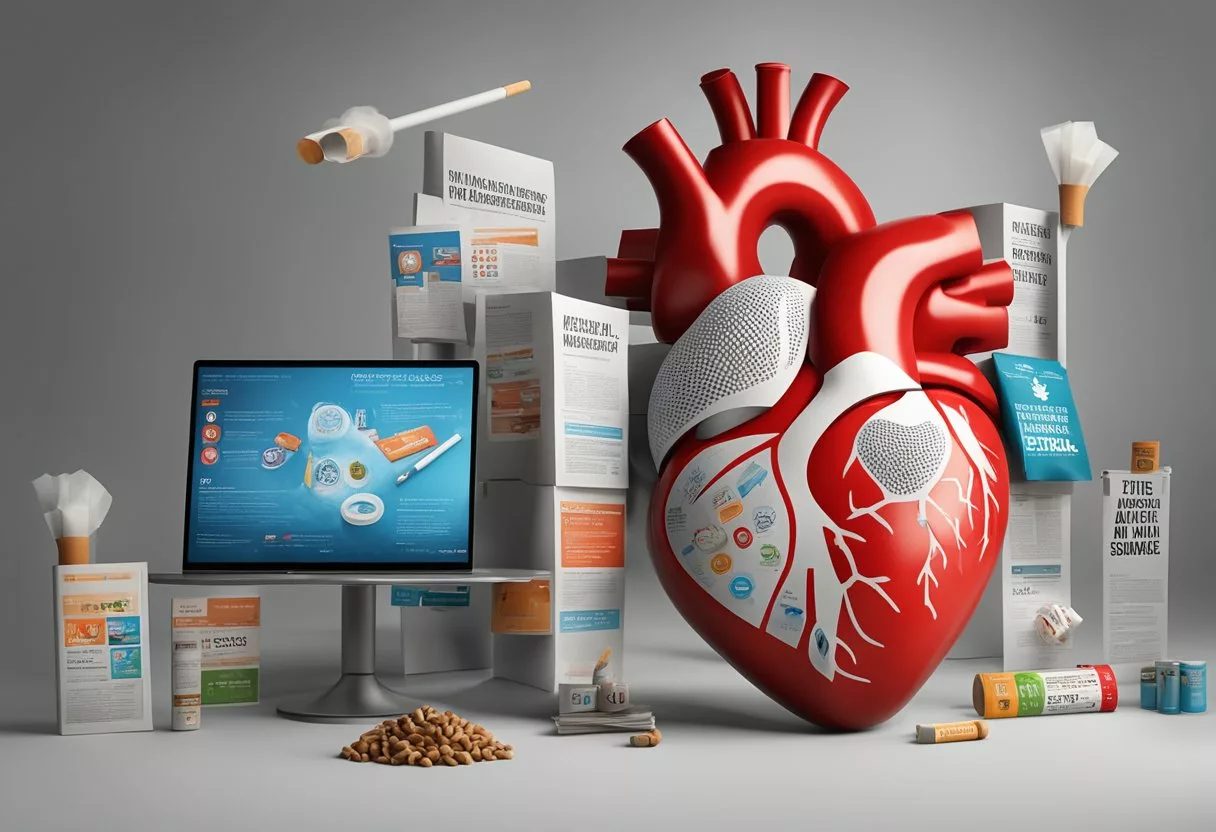Smoking significantly impacts cardiovascular health, posing severe risks to the heart and blood vessels. Smoking is a major cause of cardiovascular disease (CVD), responsible for one in every four deaths from CVD according to the CDC. The harmful chemicals in cigarettes damage blood vessels, making them more prone to atherosclerosis, a condition where plaque builds up in the arteries, severely restricting blood flow.

Cigarette smokers are 2 to 4 times more likely to develop heart disease than non-smokers. Even occasional smoking can lead to significant heart and blood vessel damage. In addition, smoking raises triglycerides, lowers “good” cholesterol (HDL), and makes blood more likely to clot, which can block blood flow to the heart and brain.
Quitting smoking provides almost immediate benefits for heart health. For instance, within just 20 minutes after quitting, heart rate drops. Over time, the risk of heart disease and stroke decreases significantly, showing the profound positive impact of giving up this dangerous habit.
Key Takeaways
- Smoking is a major cause of cardiovascular disease.
- Smokers are 2 to 4 times more likely to develop heart disease.
- Quitting smoking rapidly improves heart health.
The Effects of Smoking on Cardiovascular Health

Smoking significantly impacts cardiovascular health by damaging the heart and blood vessels. It affects blood pressure and blood flow, leading to serious health problems.
Pathophysiology of Tobacco Impact on Cardiac Functions
When a person smokes, harmful chemicals are inhaled. These chemicals include nicotine and carbon monoxide. Nicotine stimulates the release of adrenaline, increasing heart rate and blood pressure. This puts extra stress on the heart.
Carbon monoxide reduces oxygen availability in the blood. This forces the heart to work harder to supply oxygen to the body. The chemicals in cigarette smoke damage the blood vessels, leading to atherosclerosis. This condition, where plaque builds up in the arteries, can result in heart attacks and strokes.
Smoking, Blood Pressure, and Blood Flow
Smoking causes increases in blood pressure and heart rate. Nicotine causes arteries to constrict, reducing blood flow. Reduced blood flow can lead to chronic high blood pressure. Chronic high blood pressure strains the heart and can lead to heart disease.
The tars and chemicals in cigarettes make blood “stickier.” This increases the risk of clot formation. These clots can block blood flow to the heart and brain, causing heart attacks or strokes. This damage is not reversible and long-term smoking exacerbates these risks.
Secondhand Smoke and Cardiovascular Risk
Secondhand smoke exposes non-smokers to the same harmful chemicals. Even brief exposure can affect blood vessels and increase the risk of cardiovascular disease. It causes changes in blood flow and blood pressure, similar to those seen in smokers.
Children and adults exposed to secondhand smoke are at higher risk for heart disease. The risks extend to increased rates of stroke, heart attacks, and other cardiovascular problems. It’s important to limit exposure to secondhand smoke to protect cardiovascular health.
By understanding these effects, one can see the importance of avoiding smoking and exposure to secondhand smoke for maintaining cardiovascular health.
Diseases Associated with Smoking

Smoking has numerous harmful effects on the cardiovascular system, leading to various serious health conditions. Key diseases linked to smoking include heart disease, stroke, and peripheral artery disease. Each of these diseases contributes significantly to morbidity and mortality rates globally.
Coronary Heart Disease and Stroke
Smoking is a major risk factor for coronary heart disease. The chemicals in cigarette smoke cause damage to the blood vessels and heart, leading to the buildup of plaque in the arteries. This plaque buildup, known as atherosclerosis, narrows the arteries and reduces blood flow to the heart.
Stroke is another severe outcome of smoking. Smoking makes blood more likely to clot, which can block blood flow to the brain. This blockage leads to ischemic strokes, which are the most common type. Even smoking fewer than five cigarettes a day can increase the risk of stroke.
Peripheral Artery Disease and Aortic Aneurysm
Peripheral artery disease (PAD) is a condition where plaque builds up in the arteries that supply blood to the limbs, usually the legs. Smokers are significantly more likely to develop PAD due to the thickening and hardening of these arteries. This condition can lead to pain, mobility issues, and in severe cases, gangrene and amputation.
An aortic aneurysm occurs when the large blood vessel (aorta) that supplies blood to the body becomes weakened and bulges. Smoking is a primary cause of aortic aneurysms, particularly abdominal aortic aneurysms. If the aneurysm bursts, it can cause life-threatening internal bleeding.
Additional Smoking-Related Conditions
In addition to cardiovascular diseases, smoking causes a range of other serious health conditions. Smokers are at higher risk for various cancers, including lung cancer and cancers of the mouth, throat, esophagus, and bladder.
Respiratory diseases are also common among smokers. Chronic obstructive pulmonary disease (COPD), which includes chronic bronchitis and emphysema, is strongly linked to smoking. In COPD, damaged airways reduce airflow, leading to difficulty breathing and reduced quality of life.
By recognizing these risks, individuals can better understand the severe health consequences associated with smoking.
Biological Mechanisms and Risk Factors

Smoking has many harmful effects on cardiovascular health. It can lead to atherosclerosis, cause inflammation in the arteries, and increase the risk of thrombosis.
Atherosclerosis and Plaque Buildup
Smoking contributes significantly to the development of atherosclerosis. Atherosclerosis is a condition where plaque builds up in the arteries. This plaque, made from fat, cholesterol, and other substances, can harden and narrow the arteries.
Narrowed arteries reduce blood flow to essential organs. This can lead to chest pain, heart attacks, or strokes. Smokers have a higher chance of plaque buildup. The chemicals in tobacco damage the inner lining of the arteries, making it easier for plaque to accumulate. This damage also promotes the hardening of the arteries.
Inflammation and Endothelial Function
Chemicals in tobacco smoke can cause inflammation in the body. Inflammation can affect the endothelial function of the arteries. The endothelium is a thin layer of cells lining the blood vessels, responsible for proper vascular function.
When the endothelium is damaged, it can’t regulate blood flow well. This condition can lead to high blood pressure and other cardiovascular issues. The inflammation can also cause endothelial cells to attract white blood cells. These white blood cells can stick to the artery walls, compounding the damage and leading to further inflammation and plaque formation.
Hypercoagulability and Thrombosis
Hypercoagulability is the increased tendency of the blood to clot. Smoking makes the blood more prone to clotting by affecting platelets and other clotting factors. This condition increases the risk of thrombosis, where clots form inside blood vessels.
Thrombosis can obstruct blood flow, leading to severe complications like heart attacks and strokes. Smokers have more sticky platelets, which can clump together more easily. They also have higher fibrinogen levels, a protein that helps form clots. These changes in blood properties make smokers more likely to develop dangerous clots.
Demographic Considerations in Smoking-Related Cardiovascular Disease

Smoking’s impact on cardiovascular health varies across different demographic groups. This can result in diverse health outcomes based on gender and age.
Impact on Different Genders and Ages
Women: Female smokers face a higher risk of developing cardiovascular diseases (CVDs) such as coronary heart disease (CHD) compared to male smokers. It has been found women who smoke show a 25% higher risk for CHD than men with the same exposure. Genes involved in thrombin signaling contribute to this increased vulnerability.
Men: Male smokers also suffer significant cardiovascular risks, but the gender-specific response to smoking highlights women’s unique challenges. Factors like hormonal differences may play a role in these varied outcomes.
Infants: Exposure to second-hand smoke can be dangerous even for infants, impacting their cardiovascular health early in life. It can increase the risk of respiratory problems and hinder cardiovascular development.
Aging Population: As people age, the cumulative effects of smoking compound their risk for CVDs. Elderly smokers face higher chances of diseases like stroke and peripheral artery disease due to long-term damage from tobacco use. This makes smoking cessation critical at any age.
Benefits of Smoking Cessation for Heart Health

Quitting smoking leads to significant improvements in heart health, reducing disease risk and increasing life expectancy. Not only does it enhance cardiovascular function, but it also decreases mortality rates from cardiovascular diseases.
Improvements in Cardiovascular Function
Quitting smoking greatly improves cardiovascular function. Blood pressure and heart rate drop within 20 minutes of stopping smoking. Oxygen levels in the blood rise as carbon monoxide levels decrease.
Smoking cessation helps the arteries and veins. Nicotine causes blood vessels to narrow, but stopping smoking allows them to widen, improving blood flow. This reduces strain on the heart. The lungs start to clear, enabling better oxygen exchange and reducing the workload on the heart.
According to the CDC, quitting smoking also lowers inflammation and the risk of clot formation. Inflammation and clotting contribute to artery blockages, leading to coronary heart disease (CHD). Improved heart and artery function is crucial for overall cardiovascular health.
Reduction in Disease Risk and Mortality
The risk of major cardiovascular diseases drops significantly after smoking cessation. The American Heart Association reports that coronary heart disease risk falls by 50% within a year of quitting smoking. Stroke risk drops to that of a nonsmoker within 5 to 15 years.
Life expectancy increases with smoking cessation. The CDC notes that quitting can add up to 10 years to life expectancy. This dramatic increase also reflects reduced risks for heart disease, stroke, and peripheral artery disease.
The American College of Cardiology highlights that even individuals with existing cardiovascular conditions see improved outcomes when they stop smoking. Reduced disease risk and increased life expectancy illustrate the powerful impact of quitting smoking on heart health.
Prevention and Education

Preventing smoking and educating the public about its dangers is crucial for reducing cardiovascular diseases. Effective strategies include public health policies and campaigns as well as the involvement of healthcare professionals in smoking cessation.
Public Health Policies and Campaigns
Public health policies play a significant role in preventing smoking. Campaigns that highlight the dangers of tobacco use can increase public awareness and change behaviors. Programs often focus on educating young people about the risks of smoking to prevent them from starting.
Tax increases on tobacco products can reduce consumption by making them less affordable. Graphic warning labels on cigarette packs can deter smoking by showing the harmful effects. Restrictions on tobacco advertising also limit exposure to pro-smoking messages.
- Tobacco Taxes: Increased costs can deter users.
- Warning Labels: Graphic images on packs.
- Advertising Bans: Limits on tobacco promotion.
Role of Healthcare Professionals in Smoking Cessation
Healthcare professionals are vital in helping individuals quit smoking. Doctors, nurses, and other providers can offer guidance and support. They can educate patients on the benefits of quitting, which include reduced risk of cardiovascular disease and improved overall health.
Nicotine Replacement Therapy (NRT), such as patches or gum, provides safer nicotine sources to help manage withdrawal symptoms. Professionals can also prescribe medications that reduce cravings and withdrawal effects. Regular follow-up is crucial to monitor progress and provide motivation.
- Guidance and Support: Education on quitting benefits.
- Nicotine Replacement Therapy: Safer nicotine sources.
- Medications: Help manage cravings.
- Follow-Up: Ongoing support and monitoring.
Lifestyle Considerations and Support Systems
Effective strategies to quit smoking and support for individuals aiming to improve cardiovascular health are crucial. The following sections discuss smoking habits and behavioral change, and the importance of support networks and treatments.
Smoking Habits and Behavioral Change
Smoking is a harmful habit that significantly increases the risk of cardiovascular diseases. To combat this, behavioral change techniques are essential. Quitting smoking not only improves heart health but also reduces the risk of stroke. Techniques such as cognitive-behavioral therapy (CBT) and motivational interviewing can help individuals change their smoking habits.
Nicotine Replacement Therapy (NRT) like patches, gums, and lozenges can ease withdrawal symptoms and reduce cravings. Some find it helpful to set specific goals, keeping a smoking diary, or joining cessation programs. Stress management is also crucial, as elevated stress levels can prompt relapse. Methods like mindfulness and exercise can provide alternative coping mechanisms.
Support Networks and Treatments
Support from friends, family, and healthcare professionals plays a key role in smoking cessation. Having a strong support network increases the likelihood of a successful quit attempt. Support groups, both in-person and online, provide a shared space for people to discuss challenges and successes.
Healthcare providers can offer treatments tailored to individual needs. For instance, combining Nicotine Replacement Therapy with behavioral support has high success rates. Psychological support is also vital, especially for those experiencing depression or anxiety, which can hinder quitting efforts. Regular follow-ups and check-ins with a healthcare provider can offer continued encouragement and adjust treatment plans as needed.
Frequently Asked Questions

Smoking has a significant impact on cardiovascular health. The following questions address how smoking leads to heart disease, its effects on blood pressure, and the benefits of quitting.
How does smoking contribute to the development of heart disease?
Smoking damages the lining of the arteries, leading to the buildup of a substance called plaque. This can cause atherosclerosis, a condition where the arteries narrow and harden. This condition restricts blood flow and can result in heart disease and stroke.
What is the link between the number of years smoking and the risk of a heart attack?
The longer a person smokes, the greater their risk of a heart attack. Prolonged exposure to the harmful chemicals in cigarettes increases the likelihood of arterial damage and plaque buildup, which in turn heightens the risk of a heart attack.
In what way does smoking impact blood pressure and heart rate?
Smoking raises both blood pressure and heart rate immediately. Nicotine in cigarettes stimulates the body to produce adrenaline, which causes the heart to beat faster and blood vessels to narrow. This increased workload on the heart can lead to long-term cardiovascular issues.
Can quitting smoking significantly reduce the risk of cardiovascular disease?
Quitting smoking leads to immediate and long-term cardiovascular benefits. Within 20 minutes of quitting, heart rate and blood pressure drop. Over time, the risk of heart disease decreases significantly. Smoking cessation also reduces markers of inflammation and improves cholesterol levels.
What is the prevalence of heart disease among smokers compared to non-smokers?
Smokers are much more likely to develop heart disease than non-smokers. Nearly one-third of deaths from coronary heart disease are linked to smoking and secondhand smoke. Smokers also have a higher risk of developing other cardiovascular conditions.
How does tobacco use lead to the formation of arterial plaque?
Tobacco use results in the buildup of fatty substances, cholesterol, and other cellular waste products in the arteries. This accumulation, known as arterial plaque, hardens and narrows the arteries, leading to reduced blood flow and an increased risk of heart attacks and strokes.